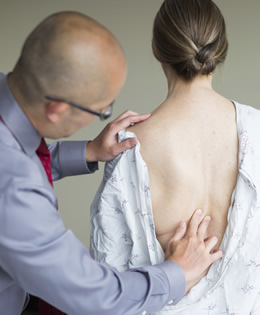Herniated Disc

A herniated disc, also called a slipped disc or ruptured disc, is one of the most common reasons people see a spine specialist.
Each spinal disc is like a jelly doughnut, with a soft center (nucleus) and tough outer shell (capsule). With a herniated disc, the capsule cracks or breaks, and the nucleus squeezes out. This can irritate the spinal cord or nearby nerves, causing weakness and numbness in the arms or legs. A severely herniated disc can cause paralysis.
Disc herniation is most common in the lower back (lumbar spine) and neck (cervical spine). Causes include age and sudden injury, such as from falling or heavy lifting. Treatment depends on how severe your symptoms are, how long you’ve had them and whether the disc is pressing on nerves or your spinal cord.
Symptoms
- Sharp, shooting pain down an arm or leg, often with neck or back pain
- Numbness or weakness in the arms or legs
- Loss of bladder or bowel control
Diagnostic test
- Discography: This test uses a needle guided by a type of X-ray to identify the spinal disc causing pain.
Nonsurgical treatments
Mild or moderate symptoms can often be treated without surgery, an approach the OHSU Spine Center favors whenever possible.
- Medication: Doctors can prescribe medications to reduce pain.
- Physical therapy: Treatments such as gentle traction and exercises such as core strength and balance training can relieve symptoms.
Minimally invasive treatment
- Epidural steroid injections: Injections can effectively treat pain caused by pressure on spinal nerves.
Surgical treatments
The type of surgery depends on where your disc or discs are, your symptoms and what your surgeon thinks is best.
- Discectomy: The most common surgery for herniated discs involves removing disc tissue pressing on a nerve or the spinal cord.
- Micro endoscopic discectomy
- Micro endoscopic posterior cervical discectomy
- Laminotomy/laminectomy: This surgical procedure removes part of a spinal bone called the lamina to relieve pressure on nerves or the spinal cord.